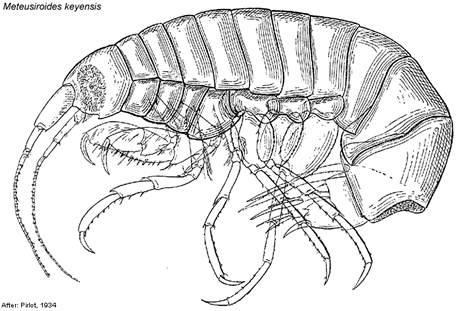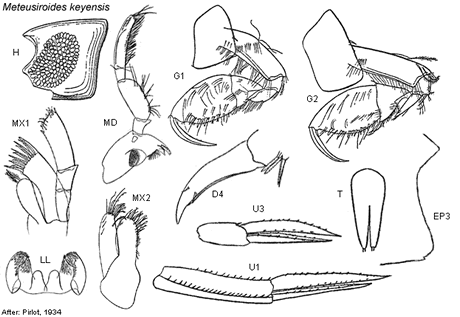 |
||||||
|
|
|
|
|
|
Australian Amphipoda: EusiridaeJ.K. Lowry, P.B Berents & R.T. Springthorpe
Meteusiroides keyensis Pirlot Meteusiroides keyensis Pirlot, 1934: 52, figs 94-96. Type material. HOLOTYPE, adult female, ZMA. Type locality. Near Kepulauan Kai, Indonesia (5º 48.2'S 132º 13'E), 304 m depth, Siboga stn 253. Description. Based on Pirlot, 1934: 52, figs 94-96. Head rostrum present, short; eyes present, eyes reniform. Body dorsally smooth. Antenna 1 subequal in length to antenna 2; accessory flagellum absent. Mandible molar columnar, triturative. Lower lip inner lobes present; outer lobes with broad gap. Maxilla 1 inner plate apically setose. Maxilla 2 inner plate subequal or slightly broader than outer; inner plate with slender medial setae, without oblique row of slender setae. Peraeon. Gnathopod 1 subchelate; subequal to gnathopod 2; coxa weakly or not produced anteroventrally; carpus not cantilevered, shorter than propodus, weakly lobed; propodus with robust setae along posterior margin (adults); dactylus narrowing distally, apically acute or subacute. Gnathopod 2 not sexually dimorphic. Gnathopod 2 subchelate; carpus not cantilevered, weakly lobed, shorter than propodus; propodus with robust setae along posterior margin (adults); dactylus narrowing distally, apically acute or subacute. Peraeopods 3-4 propodus simple. Peraeopods 5-7 dactyli inner margins smooth or minutely castellate. Pleon. Pleonites neither tricarinate. Epimeron 3 posteroventral margin smooth. Uropod 1 outer ramus shorter than inner. Uropod 3 rami subequal in length, or outer ramus shorter than inner (slightly). Telson cleft, without large apical robust setae. Habitat. Marine; soft bottom. Depth zones. Continental slope (300 m). Remarks. Meteusiroides keyensis occurs near Kepulauan Kai on the continental shelf north of Australia. Geographic areas. Extrinsic. Extrinsic distribution. Kepulauan Kai, Indonesia.
Cite this publication as: 'J.K. Lowry, P.B Berents & R.T. Springthorpe (2000 onwards). Australian Amphipoda: Eusiridae. Version: 2 October 2000. https://crustacea.net'. |
|
|
|
|
|
|
|
|
|
Copyright © Australian Museum, 2021
Australian Museum website

